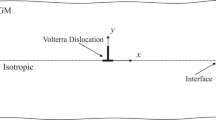Abstract
The finite element method using a singular element near the crack tip is extended to the elastodynamic problems of cracks where the displacement function of the singular element is taken from the solution of a propagating crack. The dynamic stress intensity factor for cracks of mode III or mode I deformations in a finite plate is determined.
The results of computation for stationary cracks or propagating cracks under dynamic loadings are compared with the analytical solutions of other authors. It is shown that the present method satisfactorily describes the time variation of the stress intensity factor in dynamic crack problems.
Résumé
La méthode des éléments finis utilisant un élément singulier au voisinage de l'extrémité d'une fissure a été étendue aux problèmes élastodynamiques des fissures tels qu'ils se posent lorsque la fonction de déplacement d'un élément singulier est prise à partir de la solution d'une fissure en cours de propagation. Le facteur d'intensité des contraintes dynamiques correspondant à des fissures de mode III ou des déformations de mode I dans une plaque finie a été déterminé. Les résultats des calculs correspondant à des fissures stationnaires ou des fissures en cours de propagation sous des charges dynamiques sont comparées aux solutions analytiques obtenues par d'autres auteurs. On montre que la méthode présentée décrit de façon satisfaisante la variation en fonction du temps du facteur d'intensité des contraintes dans les problèmes de fissuration dynamique.
Similar content being viewed by others
References
B.V. Kostrov,PMM (English translation), 30 (1966) 1241–1248.
R.J. Ravera and G.C. Sih,Journal of the Acoustical Society of America, 47 (1970) 875–881.
B.R. Baker,Journal of Applied Mechanics, 29 (1962) 449–458.
G.C. Sih and G.T. Embley,International Journal of Solid and Structures, 8 (1972) 977–993.
J.D. Achenbach,ZAMP, 21 (1970) 887–900.
L.B. Freund,Journal of Mechanics and Physics of Solids, 21 (1973) 47–61.
Y.M. Chen,Engineering Fracture Mechanics, 7 (1975) 653–660.
H. Stöckel and F. Auer,International Journal of Fracture, 12 (1976) 345–358.
W.K. Wilson,Methods of Analysis and Solutions of Crack Problems, Noordhoff (1973) 484–515.
P.D. Hilton and G.C. Sih,ibid, 426–483.
J.D. Achenbach and Z.P. Bazănt,Journal of Applied Mechanics, 42 (1975) 183–189.
N.M. Newmark,Transactions of ASCE, 127 (1962) 1406–1435.
H. Tadaet al. eds.,The Stress Analysis of Crack Handbook, Del Research (1973).
Author information
Authors and Affiliations
Rights and permissions
About this article
Cite this article
Aoki, S., Kishimoto, K., Kondo, H. et al. Elastodynamic analysis of crack by finite element method using singular element. Int J Fract 14, 59–68 (1978). https://doi.org/10.1007/BF00032384
Received:
Issue Date:
DOI: https://doi.org/10.1007/BF00032384




